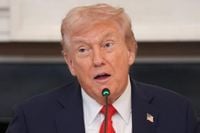In a move that has ignited fierce debate across the nation, President Donald Trump’s administration has taken steps to place the president’s image on both a commemorative $250 bill and a special $1 coin, marking the upcoming 250th anniversary of American independence in 2026. The proposals, which would break a long-standing tradition of excluding living presidents from U.S. currency, have drawn both enthusiastic support and heated criticism, with legal questions looming large over their implementation.
The controversy began in earnest on October 8, 2025, when President Trump shared an op-ed on his Truth Social account penned by Rep. Andy Barr (R-Ky.), who announced he was cosponsoring legislation to put Trump’s face on a $250 bill. The timing is no accident: the bill is meant to commemorate the 250th anniversary of the signing of the Declaration of Independence next year. According to The Daily Beast, Barr wrote that the bill would “reflect the courage of our Founders” and recognize leaders who have “revived the American Dream.” In Barr’s words, “Let us honor the president who has made America great again. A $250 bill bearing Donald J. Trump’s image is not only an appropriate tribute — it is a powerful reminder that America’s best days are still ahead.”
Barr’s op-ed also threw support behind Trump’s ongoing campaign for the Nobel Peace Prize, citing the president’s role in brokering an easing of tensions between Armenia and Azerbaijan, as well as between Cambodia and Thailand. He praised Trump’s “One Big Beautiful Bill Act,” a legislative package that extended tax cuts for the wealthiest Americans and cut more than $1 trillion from Medicaid, the government program that provides health insurance for low-income and disabled citizens. “Generations from now, when Americans hold that bill in their hands, they will be reminded that at a pivotal moment in our history, Donald J. Trump restored prosperity, security, and peace,” Barr wrote.
This push for a Trump-themed currency is not confined to paper money. On October 6, the Treasury Department, under Secretary Scott Bessent, announced plans to issue a special coinage series for the 250th anniversary, with Trump’s profile gracing the front of a commemorative $1 coin. "There is no profile more emblematic for the front of this coin than that of our serving President, Donald J. Trump," Bessent declared, according to Newsweek. The coin’s reverse is set to depict Trump with his fist raised—a reference to his response after surviving an assassination attempt at a rally in Butler, Pennsylvania, in 2024—with the words “FIGHT, FIGHT, FIGHT” encircling the image.
The announcement, widely shared on social media by U.S. Treasurer Brandon Beach and the Treasury Department, was accompanied by official posts stating, “America’s 250th Birthday is a celebration of our nation’s strength and leadership on the global stage.” The posts cited the Circulating Collectible Coin Redesign Act of 2020 as the legal basis for the new coinage, emphasizing that the designs would be “emblematic of the United States semiquincentennial” and reflect “@POTUS and his vision for America.”
But not everyone is celebrating. The move has sparked a firestorm of criticism from legal experts, historians, and political commentators. At the heart of the debate lies an 1866 Act of Congress, which, as CBS News and the Federal Reserve Bank of San Francisco have noted, was designed “to avoid the appearance of a monarchy” by forbidding living persons from appearing on U.S. currency. Defense attorney John W. Day, speaking to Newsweek, remarked, “This is another Donald Trump challenge to the status quo that will likely end up in the federal courts; existing federal law is clear that no living person may be depicted on currency… but whether the issue was resolved by the 2020 commemorative coin law remains to be seen.”
Day further explained, “The 2020 law puts some limits on who can be on the 'tails' side of a coin, but seems silent on who can be on the 'head' part. The point of the old federal law seemed to be to avoid just this conflict, where putting a current leader on the currency was a way to avoid the appearance of a monarchy. The answer ultimately will come from the U.S. Supreme Court.”
Public reaction has been swift and polarized. On X (formerly Twitter), author and former National Review editor Jonah Goldberg wrote, “If you need to break the law and tradition to put Trump on a coin to have some enthusiasm for the 250th anniversary of the founding, I question your patriotism. Trump’s ego and his lickspittles’ desire to feed it, should have nothing to do with commemorating the founding.” Constitutional law professor Anthony Michael Kreis added, “That $1 Trump coin? Not lawful in any meaningful sense of the word, but is there a viable judicial remedy? Unlikely. And is it patently illegal? Perhaps not if you apply hyper-strict textualism.” Even the official ‘Late Night with Seth Meyers’ account chimed in: “Because historically the only thing less popular in this country than Trump are the attempts to get us to start using a one-dollar coin.”
Yet, as PolitiFact and the Poynter Institute reported, the legal landscape isn’t entirely clear-cut. While the 1866 law prohibits living persons from appearing on “bonds, securities, notes, fractional or postal currency of the United States,” it does not explicitly mention coins. The Circulating Collectible Coin Redesign Act of 2020, signed into law by Trump himself, authorizes the redesign of coins for the 250th anniversary, with restrictions only on the reverse side. As Gabriel Mathy, an associate professor of economics at American University, told Poynter, “It’s unclear who would have standing to sue here.”
Historically, the United States has gone to great lengths to avoid the appearance of monarchy. Numismatic experts point out that, although there have been rare instances of living people on U.S. coins—such as President Calvin Coolidge on a 1926 commemorative coin—these were exceptions rather than the rule. The tradition of excluding living presidents from currency was intended to reinforce the republic’s values, distancing it from monarchies where the reigning leader’s face is routinely minted on coinage.
The symbolism of Trump’s proposed currency is not lost on observers. Republican politicians have even floated the idea of adding Trump’s likeness to Mount Rushmore, a testament to his influence over the party. Meanwhile, the administration’s efforts to enshrine Trump’s image on currency come amid major public events, such as the June 14, 2025, military parade in Washington, D.C., which critics noted coincided with Trump’s birthday—a move Senator Rand Paul likened to “images you saw of the Soviet Union and North Korea.”
For now, the fate of the Trump coin and $250 bill hangs in the balance. If the Treasury proceeds, it faces likely legal challenges, with many expecting the ultimate decision to rest with the U.S. Supreme Court. As the nation approaches its 250th birthday, the debate over who—and what—belongs on its money is proving to be as much about the country’s identity as it is about its currency.




